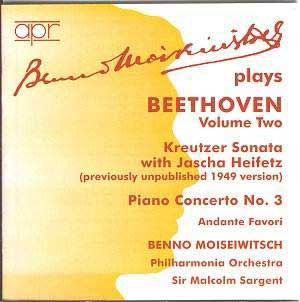I had no idea that Heifetz and Moiseiwitsch recorded
the Kreutzer Sonata in 1949 two years before their famous commercially
released collaboration. Bryan Crimp’s notes relate that the violinist
was dissatisfied with the balance in the earlier attempt and consequently
the recording remained unissued. The transfer uses Moiseiwitsch’s own
surviving set of test pressings. June 1949 was a busy time for Heifetz.
He made a European tour during which he recorded the Elgar Concerto
on the 6th June and a week later he returned to the Abbey
Road studios to make the recording which APR have now unearthed.
There is some fine declamatory chording from Moiseiwitsch
in the opening of the Kreutzer and some delicious and entirely
characteristic Heifetz slides at 2’47 immediately following the pianist’s
provocatively pliant phrasing. The balance between the instruments is
good and naturally so. We can hear a side join at 3’55 (it’s marked
with a little thump) and also the pianist’s expressive freedom and beauty
of tone. Heifetz plays with trenchant attacks, glorious finger position
changes, and the pizzicato passage works extremely well with Moiseiwitsch
a strongly supportive partner – one that the violinist may, in fact,
have felt too strong as he is overpowered in some of the more
chordally explosive passages. At 9’20 there is more succulent expressivity
from Heifetz – maybe too much – and a really impressive close to the
movement, especially by the rampant pianist. In the slow movement Heifetz
begins rather nervously; a starved note at 0’45. Moiseiwitsch’s variations
passage with the accompanying violin figuration is propulsive and luxuriant
and the now on-form violinist makes a rather naughty slide at 5’40.
One can also audibly hear the effect and effort of his passagework –
the microphone placement fractionally too close – with close up detail
of his bowing which can sometimes sound a bit "sticky." I
suspect that some of Heifetz’s objections will have concerned technical
detail, of some tiny slips of his own and microphone placement, as well
as the besetting sin of outsize violin personalities, the question of
the recorded balance between instruments. Heifetz does sound seriously
off colour around 8’12 in this movement with some approximate playing.
Again though he recovers and 10’02 his quicksilver electric trill is
deployed to magnetic effect. His high lying playing is memorable but
it’s equally true that little smudges from 12’34 intrude and he sounds
distinctly unhappy at the movement’s close – intonation is wayward.
Moiseiwitsch weights the opening chords of the finale with sensitivity
– no climactic playing here. There is much dynamic variety from Heifetz,
sharp attacks and more delicious slides. They are both masters of delicacy
and vigour in this movement, even though Heifetz’s technique proves
– whatever the myth – unreliable yet again at 4’51. Moiseiwitsch’s vertical
dynamics are splendidly effected with some scintillating left hand from
6’30 to the triumphant close.
In the Concerto Sargent’s accents are not as abrupt
as those Boult provided for Solomon a few years earlier in their famous
1944 traversal. The phrasing here is more homogenous, with dynamics
more limited and self-contained, the rise and fall of the opening less
fractious and vertiginous. At 6’45 the pianist’s descending run is elegant
– not galvanic – with sure architectural reserves in store. There is
some truly suave phrasing from the woodwind section shaped with decisive
intensity by Sargent (and here he is keenly alert to dynamics). Moiseiwitsch
points the ascending run towards the conclusion of the first movement,
before the cadenza, with exemplary skill. He plays the Reinecke cadenza
– fearsome and combustible. The slow movement is marked by inwardness,
restraint, poetic elevation and superior imagination. Sargent succeeds
in bringing out some exquisite orchestral writing, some string pizzicati,
and the sense of harmonic questing is implicit in the syntax of their
collective playing. The strong string replies to the pianist at 5’01
are truly admirable. All very impressive. In the finale Moiseiwitsch’s
skill at articulating the left hand is invincible; this is not some
treble orientated performance, as many are, with interplay between hands
subsumed; this is a true elucidation of the text in which both hands
are equally engaged and made to sound so. There is also an often-overlooked
spruce humour here not least in the orchestral contributions that make
this a most commanding and enviably all-embracing performance. The Andante
Favori was a favourite of Moiseiwitsch’s and first recorded by him in
1930. He was later to record it again in 1960 for Brunswick, his last
session. As ever he is alive to the moods and wanderings of this delightful
piece with mobile and affectionate phrasing.
Bryan Crimp notes that the surviving test pressings
of the Kreutzer were in somewhat battered condition. In which case he
has effected a marvel of transfer because apart from one side join and
a few clicks it is a more than pleasurable experience to listen to this
previously unissued performance. His notes are judicious and analytical.
A very strong recommendation.
Jonathan Woolf


